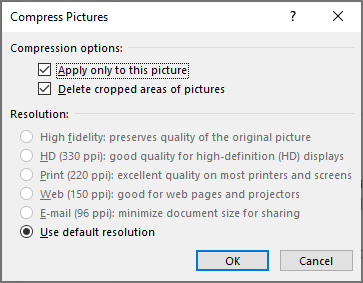


These features aren’t available in Office for the web, only the desktop versions of the Office suite. You can compress all pictures in the file or just the ones that you select. The compression options reduce both the file size and picture dimensions based on how you intend to use the picture, such as viewing on screen or in an email message. You can reduce the file size and save disk space by compressing pictures in your document. The image or images will now be compressed. Also, if you want to delete the cropped areas of the pictures, check the box next to that option. Select the picture quality you’d like to use, then select if you’d like to apply the compression to all images in the presentation or only the selected image. The “Compress Pictures” window will appear. Once selected, click “Compress Pictures” in the “Picture Format” tab. Open the PowerPoint presentation that contains the images you’d like to compress and then select a photo. In the “Resolution” group, choose which resolution you would like to use. If you uncheck this option, PowerPoint will compress all of the images in the presentation, which overrides any changes you may have made to those images. In the “Compression Options” group, you can choose if the compression applies only to the selected picture. Here, click the “Compress Pictures” button in the “Adjust” group. Once selected, you’ll automatically be in the “Picture Format” tab.
HOW TO COMPRESS PICTURE IN EXCEL WINDOWS
Compress Images in PowerPoint for Windows Note that this feature is only available for desktop versions of Office and not Office for the web.
HOW TO COMPRESS PICTURE IN EXCEL HOW TO
Here’s how to compress images in Microsoft PowerPoint. Luckily, Microsoft gives you various options to match how you plan on presenting your work, whether it be through the web, print, or in person.Ĭompressing images in your Microsoft PowerPoint presentation can help reduce the overall file size of the presentation and save disk space on the device it’s stored on. However, if you’re files are getting too large, it might be wise to compress the size of those images. Unlike a Microsoft Word document, a PowerPoint presentation is meant to impress your audience through a balanced combination of images, animation, and text. In the same pop-up, under Compression options, choose either All pictures in this file or Selected pictures only.This roughly translates to dots per inch (dpi) on a printout. The smaller the PPI (pixels per inch), the smaller the image.

In the pop-up menu, you can choose from five resolution levels from the pull-down menu, including high fidelity, HD, Print, Web, E-Mail, or default.If you’re using Microsoft PowerPoint for Mac, the steps are nearly the same. In the same pop-up, under Compression options, choose Apple only to this picture, if applicable.The smaller the ppi, the smaller the image. In the pop-up menu, you can choose from five resolution levels, including high fidelity, HD, Print, Web, E-Mail, or default.Choose Compress Pictures under the Pictures Format menu.Double-click on an image in your presentation.Here’s how to do on both Microsoft PowerPoint for Windows and Mac. Thankfully, Microsoft makes it possible to compress images in the app in just a few steps. Microsoft PowerPoint files can grow very large, depending on the number of images and other media files you use in the presentation. Compression changes will not be saved until you explicitly save them. Note: You can undo compression by clicking Undo Compress Picture on the Edit menu. To compress your pictures for sending in an e-mail message, under Compress for, click E-mail messages. To compress your pictures for publication on a Web page, under Compress for, click Web pages. To compress your pictures for insertion into a document, under Compress for, click Documents. On the Picture menu, click Compress Pictures. Note: You can undo compression by clicking Reset Picture. Some pictures will only allow one or two of these options.Ĭlick OK, and name and save the compressed picture somewhere you can find it. To compress your pictures for sending in an e-mail message, under Resolution, click E-mail. To compress your pictures for publication on a Web page, under Resolution, click Web. To compress your pictures for insertion into a document, under Resolution, click Print. The compression options in Microsoft Picture Manager reduce both file size and picture dimensions based on how you intend to use the picture, such as in Web pages or e-mail messages.Ĭlick the Picture Tools Format tab, and then click Compress Pictures.


 0 kommentar(er)
0 kommentar(er)
